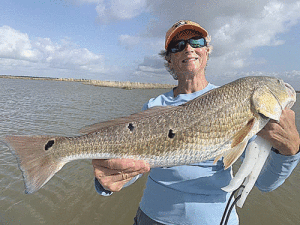
“Braggin’ Rights”
Bay Flats Lodge
November is generally the initial month for some fairly noticeable transitions along the Texas Gulf coast. This means we should have already experienced a couple significant cooling trends, and air and water temperatures will have already begun to drop as a direct result. Along with changing weather conditions, we will begin to experience other types of transitions, as well. The first transition, this month will be the incorporation of Daylight Savings Time, which means we’ll begin seeing less daylight with each passing day. We’ll be officially entering into the wintertime months, so another change would be that we should learn to expect a greater potential for foul weather as we proceed into colder months. Another transition will be the fact that trout and reds will now begin looking for mud and grass or mud and shell instead of sand. The sand is great for spring and summertime conditions where the fish are looking for the warmth of the sun to reflect off the sand, but when the days turn cold those fish are going to be looking for warmth that can only be radiated and stored by that of thick, black mud.
Another transition taking place this month will be the metabolism of the fish. As early as two or three weeks ago these fish were probably eating a meal at every opportunity, or whenever they had a craving to do so. Once the temperature of the wind and the water have dropped considerably, so too shall the feeding periods for the fish. Fish often get quite lethargic during the colder months of the year, and their feeding pattern slows down greatly as a result. They would probably much rather eat one large meal instead of expounding the energy of eating several small meals throughout the course of each day. This is the very reason why anglers should always cast to a single mullet jumping in the wintertime. More times than not, the single mullet that is jumping is really big and is being slowly chased by a really hungry trout or redfish that’s looking for their one, single meal for that day.
Your choice of artificial baits should also begin a transition in November. As mentioned earlier, the fish are sometimes chasing one large meal per day, so you should start tossing much larger surface baits beginning in November. In doing so, you should also begin slowing your retrieve to a snail’s pace, often raising the tip of the rod only once or twice in a 10-15 second period. Also, begin using darker baits this month as they tend to portray a much more distinctive silhouette and work exceptionally well in low-light conditions. Until next time, tight lines to all!
